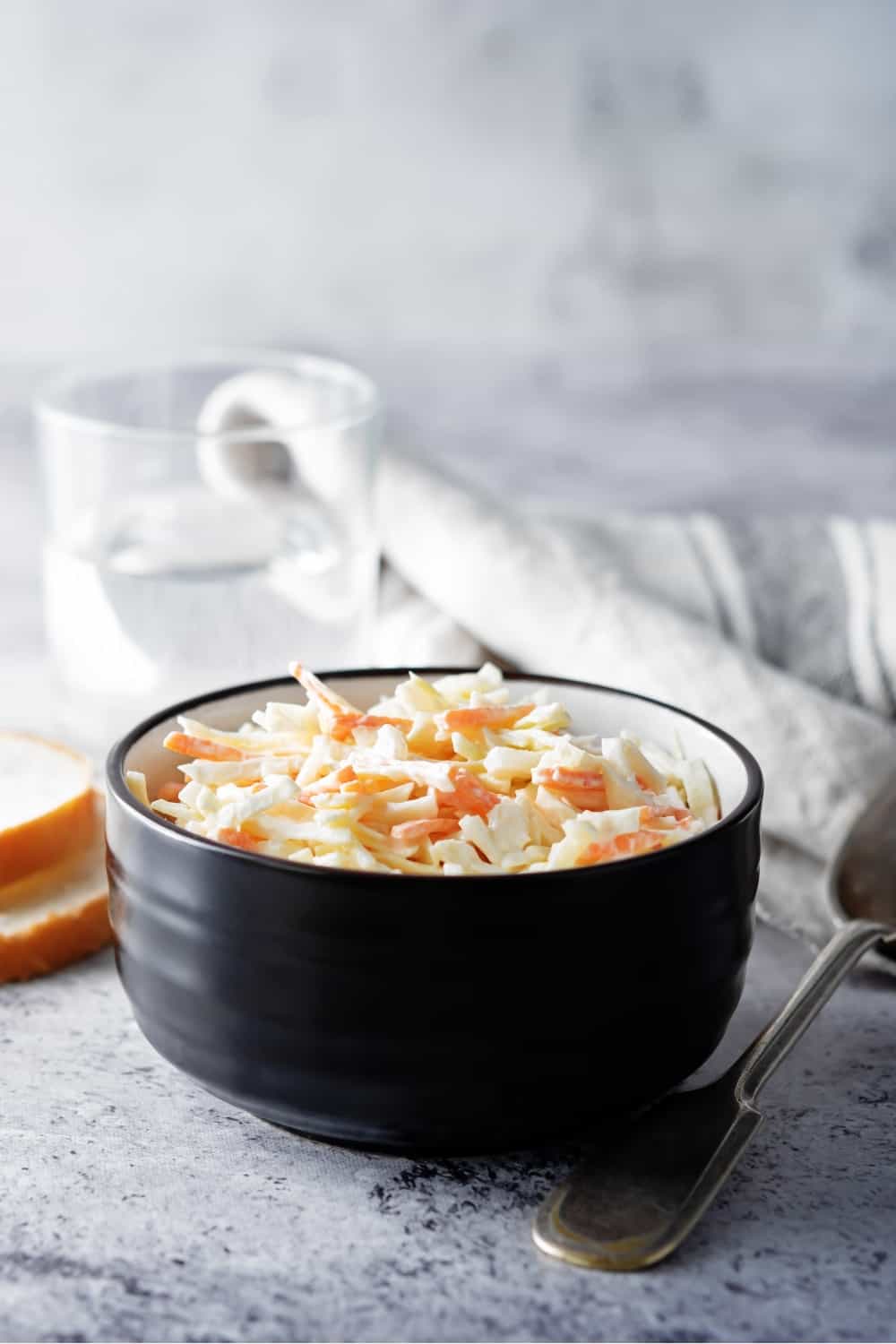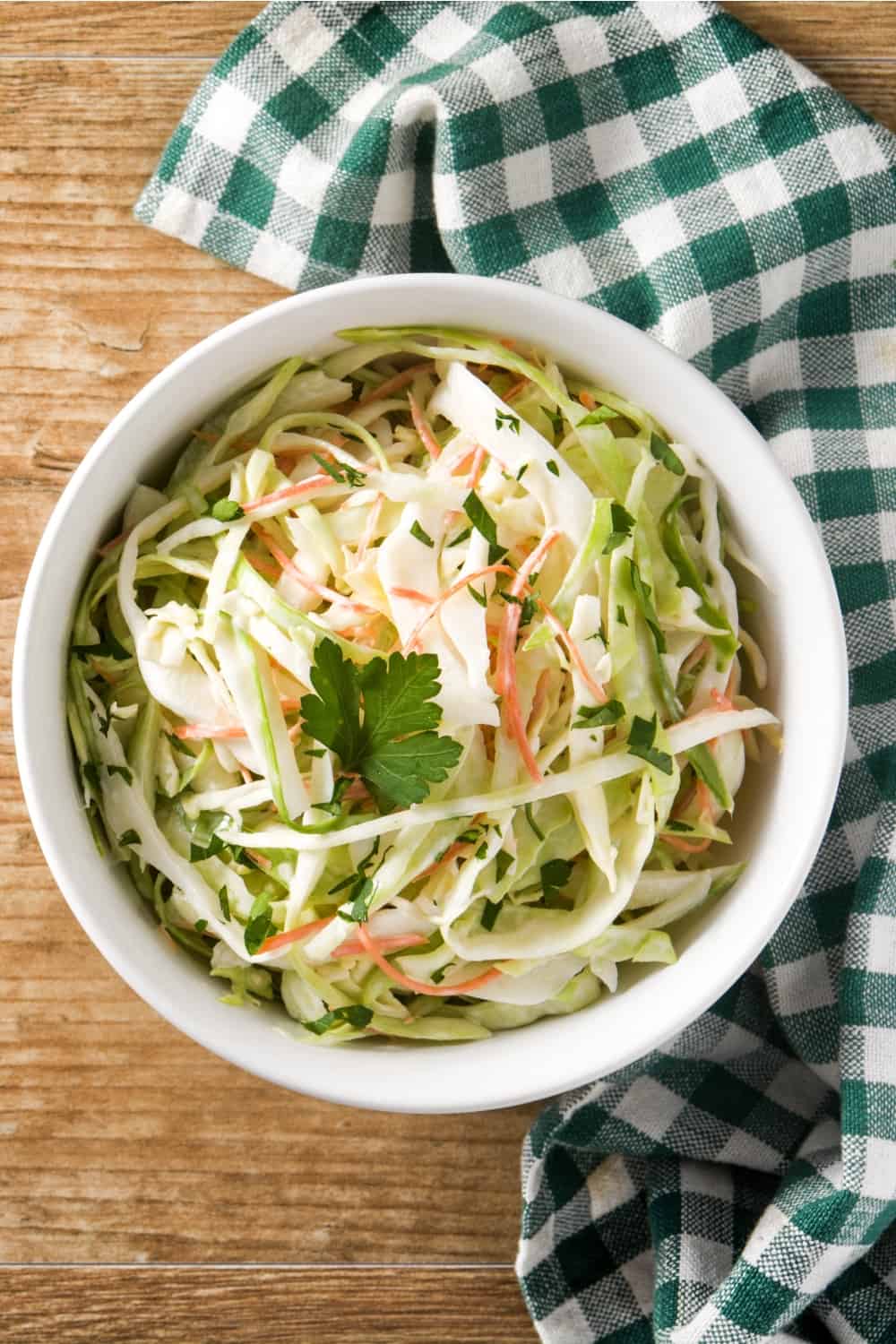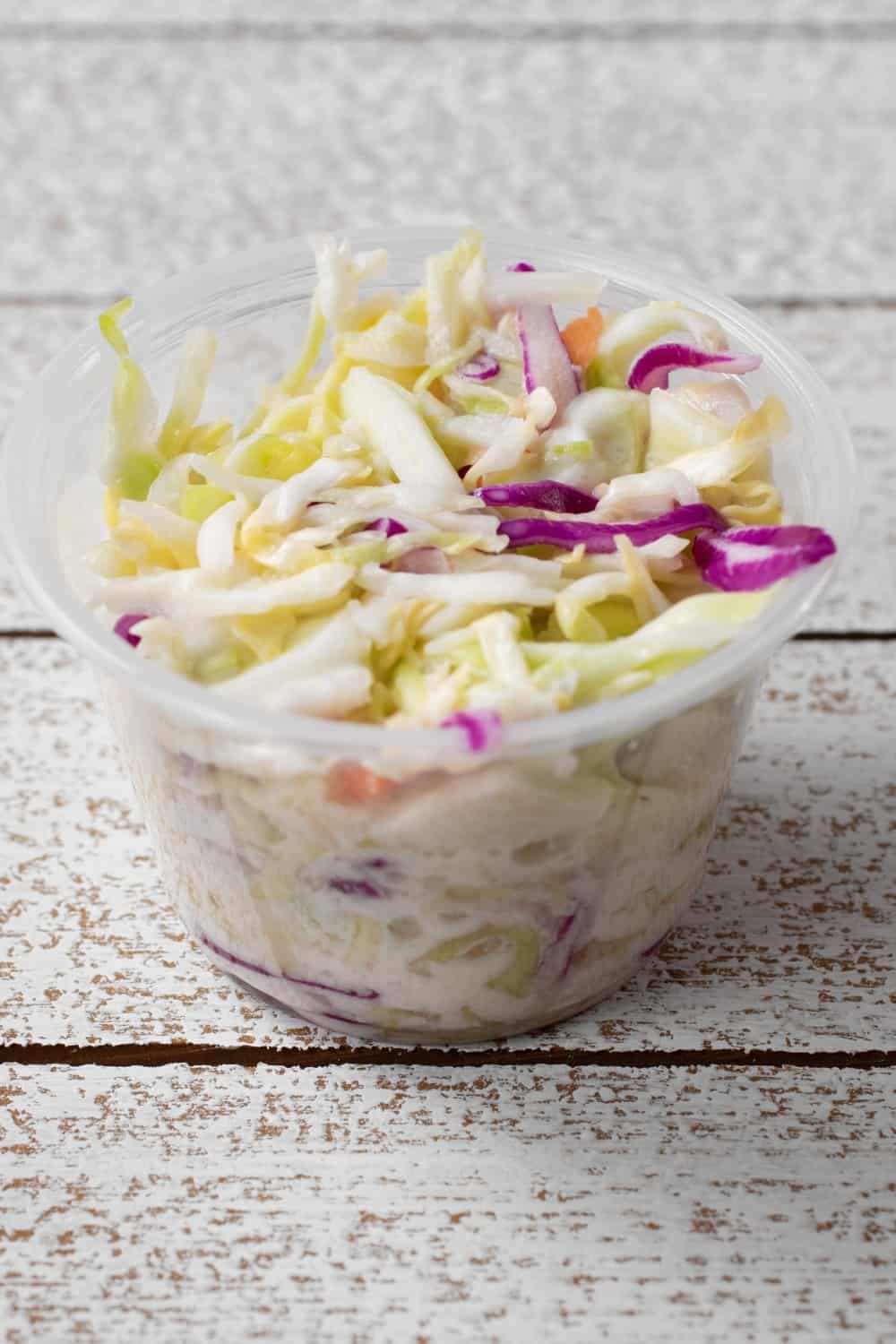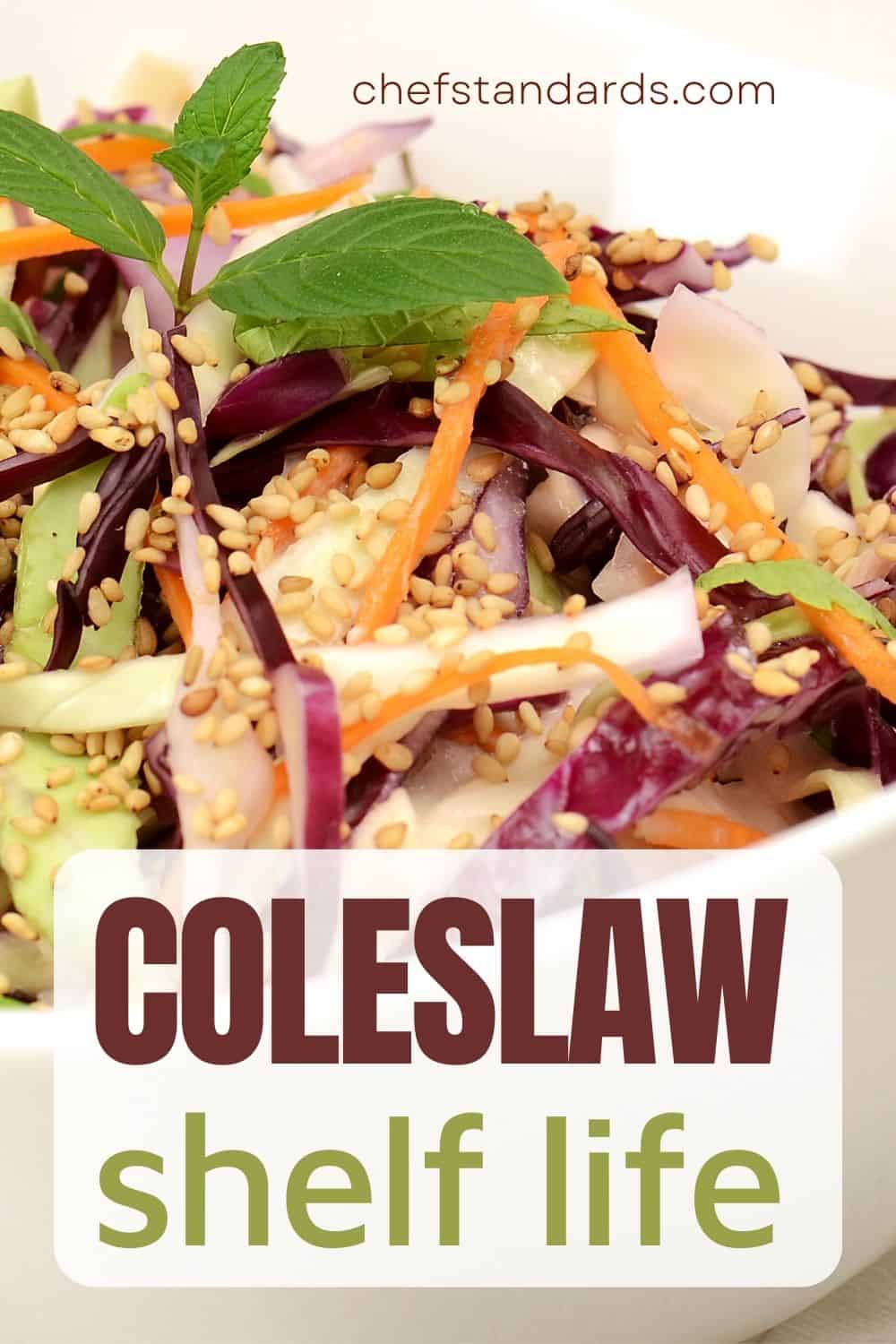What is better than enriching your meal with some refreshing and delicious side dish from time to time?
Besides chicken salad or potato salad, there is one type of side dish that can perfectly serve this purpose and that is coleslaw, also called “slaw”.
It is a perfect combo of various veggies and delicious dressings that can be suitable for everyone’s taste buds.
Unfortunately, coleslaw has one downside, and that is its short shelf life. So, how long is coleslaw good for?
Well, although the exact shelf life depends on the ingredients and storage conditions, most types of coleslaw won’t last more than just a few days.
It is therefore important to know how long exactly it is, how to recognize spoilage signs, and how to store it the right way.
What Exactly Is In Coleslaw?

Before I get to the main point, I will just say a few words about coleslaw itself in order to provide you with the bigger picture.
Well, you already know that it is a popular side dish for sandwiches and other dishes, but what are the main ingredients in coleslaw? The base of every coleslaw is cabbage.
In fact, the term “coleslaw” is derived from the Dutch word “koolsla,” which means “cabbage salad”.
Other ingredients mostly include vegetables like carrots, onions, and bell peppers, but there are no exact limitations.
Those veggies are mixed with a salad dressing, mostly made from mayonnaise, vinegar, or a combination of both.
It can have a range of flavors, from tangy and creamy to sweet and crunchy, depending on the specific recipe and dressing used.
How Long Does Coleslaw Last?
As I previously stated, the shelf life of coleslaw is quite short, but the exact duration mainly depends on the storage conditions. Ingredients and the type of coleslaw also play a significant role.

Homemade Coleslaw
If you decide to make your own culinary masterpiece, you have to know that it will have the shortest shelf life. Besides the fact that it is made with fresh ingredients, the absence of preservatives also contributes to this.
So, once you have made the coleslaw, it is advisable to put it in the fridge as fast as you can if you don’t want to consume it right away.
Namely, if you leave it at room temperature for more than 2 hours, harmful bacteria will begin to grow rapidly.
This is because room temperature falls in the category of the so-called “temperature danger zone” (40°F -140°F), which is the ideal zone for bacteria to thrive.
If you are in the middle of a hot summer’s day and the temperature is above 90°F, you shouldn’t keep your coleslaw outside for more than 1 hour.
When it comes to refrigeration, freshly made coleslaw can last for about 3-5 days, of course, if you store it the right way.
However, you should also know that the freshness and quality may start to decline even after a day or two, so take that into consideration as well.
Store-Bought Coleslaw
It is a different story with store-bought coleslaw. Because it usually contains some preservatives, it can last a bit longer.
However, in this case, it is important to check the date printed on the label of the packaging and handle it according to that date.
You can keep it in the fridge for up to that date, but it can stay good for 1-2 days past that date, although the quality probably won’t be the same.
Once you open it, the date doesn’t mean anything anymore.
This is because you have about 3-4 days left until it is ready for tossing.
When it comes to room temperature, the same rule applies as with homemade ones. Do not keep it outside for more than 2 hours, and if it is really warm outside, put it in the fridge within 1 hour.
Leftover Coleslaw
Coleslaw leftovers can be particularly sensitive to deal with because they were already exposed to the outside world.
The 2-hour rule suggests that if the leftovers haven’t been left outside for more than 1 or 2 hours, you can put them in the fridge. However, you shouldn’t let them stay there for more than 2 to 3 days.
From my own experience, I would advise you to refrigerate leftovers for a maximum of 2 days because, at the end of the second day, the quality is already very low.
What Are The Signs Of Spoilage?

You now know approximately how long coleslaw can last in all of its forms. However, there can be times when you can’t remember the exact day when you put it in the fridge. In that case, knowing the major spoilage signs is very important.
• Foul or Off Odor: One of the first signs of spoiled coleslaw is a strong, unpleasant odor.
If your coleslaw emits a sour, rancid, or putrid smell, it is likely no longer safe to consume. This odor may indicate the presence of harmful bacteria or mold.
• Mold: Since there is a lot of moisture in coleslaw, mold can easily start forming. If you notice any mold on the surface of the coleslaw, it is a clear indication that the dish has spoiled.
Molds on food can appear as fuzzy patches or spots of various colors, such as green, black, or white.
• Discoloration: Coleslaw that has gone bad may exhibit significant discoloration. Instead of the vibrant and fresh appearance of the vegetables, it may look faded or discolored.
The cabbage and other vegetables may appear dull, brownish, or yellowish, so if you see that, your coleslaw is, unfortunately, ready for the trash.
• Slimy Texture: Fresh coleslaw typically has a crisp and crunchy texture. If the cabbage, carrots, or other vegetables in the coleslaw appear slimy or excessively soft, it suggests that the coleslaw has deteriorated.
Sometimes, this doesn’t necessarily mean that it is spoiled, but it is always better to toss it in order to stay on the safe side.
• Bad Taste: Finally, if all of these signs are absent but you still aren’t sure of the freshness of your coleslaw, you can give it a taste. If you notice an abnormal or off-taste, such as a sour or bitterness, the coleslaw is not for eating anymore.
How To Store It Properly?

The key to proper storage of coleslaw is in the refrigerator. No matter what type of coleslaw are you dealing with, or what are the ingredients inside, it is essential that you keep it inside the fridge.
In order to do that the right way, it is best to transfer your coleslaw to an airtight container. When you go through that process, it is essential that you use clean utensils.
My advice is to always use one type of spoon just for the coleslaw in order to avoid cross-contamination.
After successfully putting it in the container, you must seal it properly. A container with a tight-fitting lid is ideal because it helps prevent air exposure, which can cause the coleslaw to dry out and deteriorate quickly.
It also helps to maintain the flavors and textures of the ingredients.
If you have a large amount of coleslaw, it’s advisable to divide it into smaller portions before refrigerating. This will allow easier cooling and help maintain the quality of the remaining coleslaw when you take a portion out.
Finally, it is important that you store it at the right temperature. The ideal temperature for coleslaw in the refrigerator is 40°F.
Also, you should put it somewhere far from the fridge door to provide it with a stable temperature.
My final advice is to store your coleslaw away from raw meats, seafood, or any other potentially contaminated foods, as this can lead to cross-contamination.
How To Extend The Shelf Life Of Coleslaw?

There are always ways to make things better and that is true in the case of coleslaw’s shelf life as well. So, now I will share a few tips on how to successfully extend the shelf life of your coleslaw.
• Properly Wash and Dry Ingredients: Thoroughly wash the cabbage, carrots, and other vegetables before shredding or slicing them for coleslaw. Washing helps to remove any dirt or potential contaminants.
After washing, make sure to dry the vegetables thoroughly to prevent excess moisture, which can lead to faster spoilage.
• Optimal Preparation is the Key: When preparing coleslaw, avoid over-shredding or cutting the vegetables too finely.
Larger shreds or slices can help maintain the texture and prevent the coleslaw from becoming mushy. It also helps the coleslaw retain its crispness for a longer period.
• Wilt Vegetables Ahead: You should do this if you want to avoid ending up with watery coleslaw. After shredding the cabbage, you must add salt and leave it until it wilts.
When that happens, rinse and spin in a salad spinner to dry. This process will eliminate excess water from the cabbage, helping you to avoid watery coleslaw.
• Add Acidic Ingredients: Incorporate acidic ingredients such as vinegar or lemon juice into the dressing.
The acidity helps to preserve the coleslaw and inhibits bacterial growth. Acidic environments are less conducive to bacterial multiplication, thus extending the shelf life of the coleslaw.
• Store Veggies and Dressing Separately: Consider keeping the dressing separate until you’re ready to serve the coleslaw.
This prevents the vegetables from becoming soggy or wilted. Mix the dressing with the coleslaw just before serving to maintain its freshness.
Can You Freeze Coleslaw?

In general, freezing is one of the best ways to preserve food for longer. Unfortunately, not all types of food freeze well.
Is this the case with freezing coleslaw? Generally speaking, yes, but a lot of that also depends on the ingredients, particularly salad dressing.
If the base ingredient of the salad dressing is mayonnaise or if it is some other type of creamy dressing, freezing is not an ideal solution.
This is because mayonnaise is an emulsion of oil, egg yolks, vinegar, and other ingredients. Freezing mayonnaise can cause the emulsion to break, resulting in a separation of the oil and water components.
After thawing, it ends up in a mess. So, if you don’t want your coleslaw to end up like this, avoid freezing it if it contains mayo-based dressing.
Fortunately, mayo-based dressing is not the only type of dressing, but you can also make vinegar-based ones.
This one is much more suitable for freezing because vinegar doesn’t break down in the process, and it helps to preserve the veggies as well.
So, if you have some coleslaw with vinegar-based dressing and want to freeze it, it is important to first make sure that it is properly chilled in the refrigerator before the process.
After that, you must transfer it to airtight freezer-safe containers or freezer bags. Ensure that the containers are properly sealed to prevent air exposure and freezer burn. Squeeze out as much air as possible from the freezer bags before sealing.
After you label it with the exact date of storage, you can freely put it in the freezer and it will last for up to 2-3 months.
Once you decide to consume it, it is best that you thaw it in the fridge overnight as this is the safest method to pursue.
Summary
So how long is coleslaw good for?
Homemade coleslaw can last up to 3-4 days in the fridge if stored properly.
Unopened store-bought coleslaw can stay good in the refrigerator for 2-3 days past the printed date. Once you open it, you must consume it within 3-4 days.
Coleslaw leftovers can stay in the fridge for up to 2-3 days.
All types of coleslaw can not stay at room temperature for more than 2 hours, or 1 hour if the temperature is above 90°F.
Also, all types of coleslaw that are not mayo-based can be kept in the freezer for up to 2-3 months.


